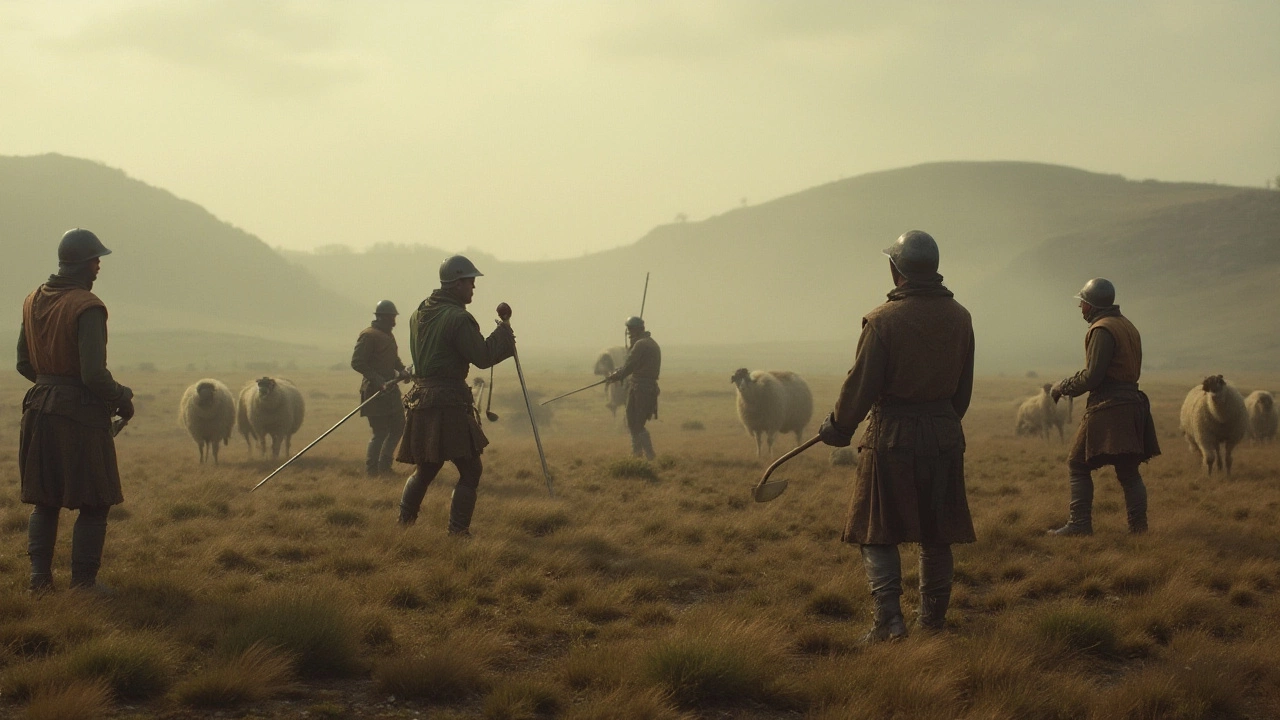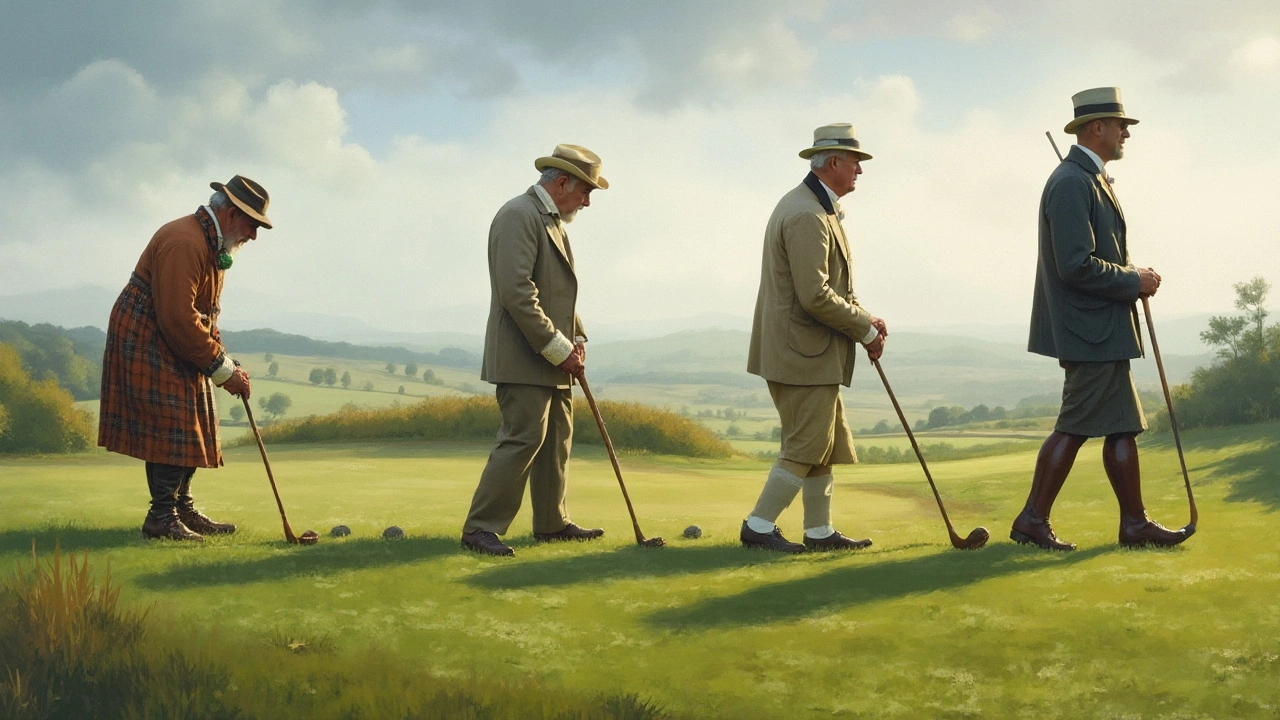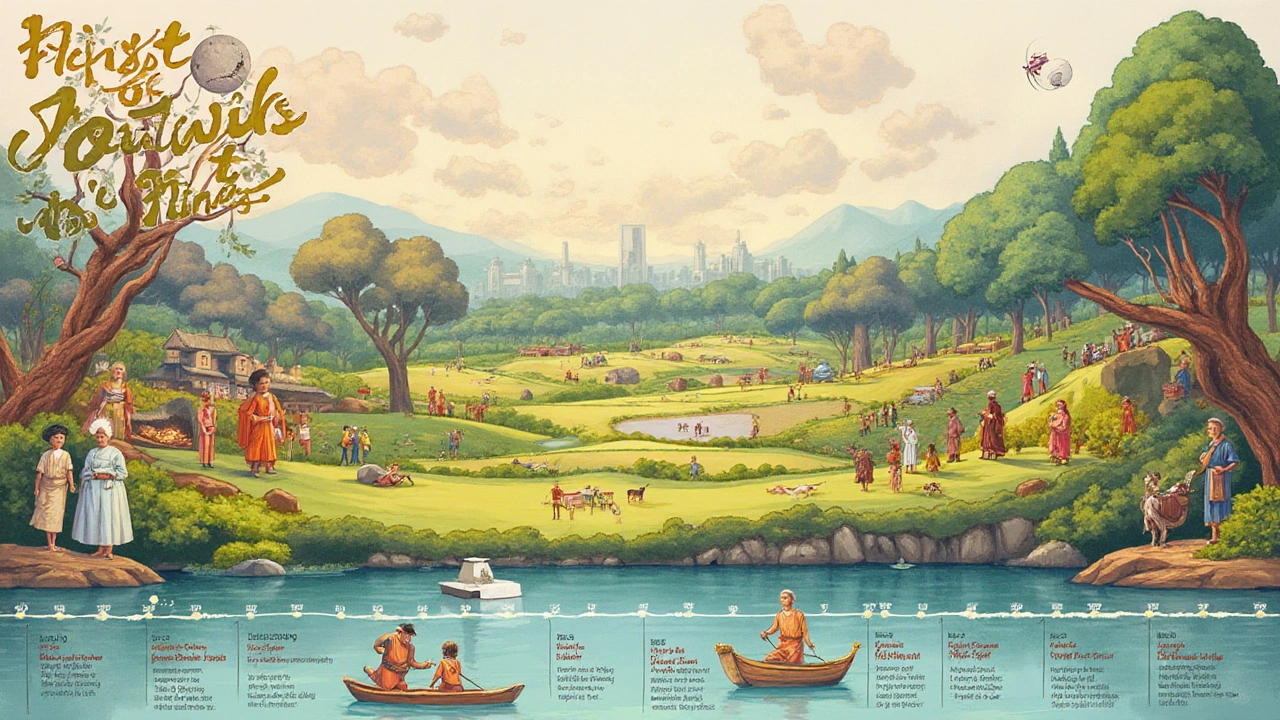Discovering the Origins of Golf: A Journey Through History
 Nov, 24 2024
Nov, 24 2024
Golf is more than just hitting a ball into a hole; it's a game with a captivating history that has been played and cherished by many throughout the ages. The tale of golf's beginnings weaves through ancient pastimes and remote landscapes, eventually catching the wind to become a sport loved worldwide.
Understanding the origins of golf is like piecing together a puzzle from fragments of history. Various societies claim a hand in its creation, suggesting that this beloved sport may have been born from a blend of cultures and traditions. As we explore each theory, we uncover a richer understanding of how golf took on the form we recognize today. From Scotland's windswept links to distant shores, the evolution of golf is not just a story about sport but a reflection of historical changes and cultural exchanges.
Join us on this intriguing journey as we delve into the genesis of golf, uncovering its ancient roots and witnessing its remarkable transformation over time.
- Ancient Roots and Early Games
- The Role of Scotland in Golf's History
- Evolution to Modern Golf
- Golf's Global Expansion
- Interesting Facts and Tips
Ancient Roots and Early Games
The origins of golf are as mysterious as they are fascinating, drawing interest from those eager to understand how this beloved sport came to be. While Scotland is widely considered the home of modern golf, the game's ancient roots stretch across various cultures and centuries, long before it became formalized in the Scottish highlands. One of the earliest known games resembling golf was a Roman pastime called 'paganica,' which involved players hitting a stuffed leather ball with a bent stick. This simple activity has often been cited as an ancestor of modern golf, suggesting that the fundamental appeal of striking a ball towards a target transcends time and geography.
Further evidence of early golf-like activities can be found in the Netherlands, where a game known as 'kolf' was played as early as the 13th century. This game employed sticks and a ball, much like golf, and was particularly popular among Dutch communities during harsh winters. Unlike modern golf, however, kolf was played on ice or in any open space, sometimes in churchyards or public roads, which adds a unique flair to its historical context. The similarity of these games to golf is no coincidence; rather, they reflect the enduring human enjoyment of propelling a ball across a distance, a theme consistent throughout history.
Moving eastwards, evidence of golf-like activities is even found in China, where a game called 'chuiwan' was prevalent during the Song Dynasty (960–1279). Description and illustrations of chuiwan, detailed in ancient Chinese manuals, depict players swinging clubs to send balls into holes, which remarkably mimics modern golfing techniques. There's a romantic notion that the spread of the Mongolian Empire allowed such games to traverse continents, possibly influencing European variations like those found in Scotland and the Netherlands. This cross-cultural exchange is a testament to golf's history being an intersection of different cultures embracing and adapting the game's basic concept to fit their landscapes and traditions.
Despite these compelling narratives, some historians caution against directly linking these past games to the birth of golf as we know it. Iain Anderson, a noted historian on sporting origins, famously suggested,
"The origins of golf are entwined with the development of ball games across different cultures, not easily attributable to a single lineage or descent."Such caution is warranted, given how diverse historical accounts can be, but it doesn't diminish the excitement of tracing golf's ancestry. It merely adds layers to its evolutionary tapestry.
The Impact of Geography on Early Golf
Geography played a critical role in shaping early golf-like games. The rugged landscapes of Scotland, where golf ultimately blossomed, provided naturally challenging terrains that influenced the game's development. These landscapes enforced strategic thinking and skill development, lessons that early golfers learned to appreciate. Meanwhile, Dutch kolf was shaped by the abundance of flat, frozen surfaces, favoring games on ice and fostering a communal spirit. Chinese chuiwan, played in courtly settings, highlighted precision and elegance. The unique geographical settings of these games reflect how the physical world has influenced not only the rules and equipment used but also the culture and ethos surrounding the sport.
This confluence of ancient activities across various regions paints a broader picture of how human ingenuity and the love for games have organically led to what we celebrate today as golf's history. Each geographical context left its mark on how the game evolved, intertwining elements from pastimes and passing them down through generations.
The Role of Scotland in Golf's History
Scotland is fondly regarded as the birthplace of golf, a declaration earning it a revered place in the annals of the game's history. The landscape of Scotland, with its rugged coastlines and expansive moorlands, not only offered ideal terrain for the sport but also played a pivotal role in the game's early development and dissemination. By the 15th century, a game quite akin to the modern day golf was already being played on the eastern coast of Scotland, where fields were transformed into makeshift courses, amidst hills and valleys, giving birth to what we now know as 'links'. Legislative records from 1457 first mentioned the sport when the Scottish Parliament under King James II sought to ban it, believing it was a distraction from military pursuits such as archery. This fascinating historical document underscores how deeply embedded golf was within the Scottish society of the era.
As centuries progressed, the charm of golf grew, partially thanks to the patronage of royalty, including King James IV, who overturned the ban to indulge in the sport himself. The Royal and Ancient Golf Club of St Andrews, founded in 1754, further cemented Scotland's place in golf's pantheon, becoming a pivotal institution for the sport. St Andrews, often dubbed the 'Home of Golf', established many of the game's first rules and hosted early competitions that drew players from all over, eager to participate in what was becoming more than just a leisurely pursuit – a sport of skill and strategy. The Old Course at St Andrews is often regarded as the linchpin of the sport's historical legacy, drawing golfers for more than six centuries.
Scotland leaves its mark not only through course designs but also through the culture surrounding golf. It introduced the idea of public courses, making the game accessible to a broad spectrum of people, as highlighted by the Leith Links. This democratization of the sport fostered a communal sense of ownership and pride, attributes still embraced by global golfing communities today. A tradition of openness and hospitality defines the ethos of Scottish courses, encouraging people from all walks of life to embrace the game.
"There is no game which puts you in touch with Scotland and the Scottish countryside quite like golf," writes author and golf historian, Pat Ward-Thomas.
Scotland's influence on golf has extended beyond its borders, shaping courses worldwide, with its iconic links-style layouts inspiring course design all around the globe, such as Pebble Beach in the United States or Royal Melbourne in Australia, echoing the spirit of Scottish golf.

Evolution to Modern Golf
The journey of golf from its early forms to the modern game we recognize today is a fascinating tale of adaptation and innovation. As we trace this evolution, it becomes clear that each shift in the development of golf was influenced by both social changes and advancements in equipment technology. Back in the 15th century, when the game began to shape more distinctly in Scotland, it was played in its raw form with rudimentary clubs and leather-bound balls. Those early rounds, played across the natural landscapes of the Scottish coast, bore little resemblance to the manicured greens and courses that exist today.
In the mid-18th century, a crucial development occurred when the Honourable Company of Edinburgh Golfers assembled and drafted the first formal rules of golf. This helped to solidify the essence of the game and provided a framework that allowed golf to be taken more seriously as a sport. As the rules settled, so too did the design of courses and equipment. Clubs evolved from hand-crafted by skilled artisans to more precisely engineered instruments, thanks to the industrial innovations of the 19th century. Around the same time, the invention of the Haskell ball, a rubber-cored ball which was cheaper and traveled further, greatly influenced the game’s accessibility and popularity.
During the late 19th century, golf crossed national borders and began gaining traction outside the British Isles. By this time, architects like Old Tom Morris had started designing courses with greater complexity, considering not just the challenge of the terrain but also the aesthetic beauty of its surroundings. This was the era when some of the most famous courses were developed, many of which are still revered today. With its growing international appeal, the need for standardized tournaments emerged, leading to the establishment of prestigious competitions such as The Open Championship, the oldest of the major championships, which was first held in 1860.
The transformation of professional golf courses into venues for grand spectacles was further advanced by the rise of media in the 20th century. Televised golf brought the sport into living rooms around the world, endearing it to countless new fans who could experience the drama and excitement of matches played by legends. In an interview with the BBC, golf historian David Joy remarked,
"The evolution of golf reflects a tapestry of cultural and technological milestones, each contributing layer upon layer to what it has become today."
The 21st century ushered in a new chapter in golf's evolution. Clubs and balls have become high-tech, often using computer-aided design to perfect their performance. Meanwhile, golf courses face new challenges, including sustainable environmental practices and conserving natural resources. As the sport continues to evolve, embracing technology and innovation while holding on to its rich traditions, it remains as popular as ever, beloved by both players and fans around the globe, and a testament to its unceasing appeal through the ages.
Golf's Global Expansion
As the sport of golf gradually evolved in the scenic landscapes of Scotland, a vital transformation began to unfold, marking its journey from local pastimes to a recognized global sport. The global expansion of golf is a fascinating tale of cultural exchange and adaptation, well worth exploring. This period saw a rapid increase in the popularity of golf courses across continents, driven by influential figures and the spread of British influence during the colonial era. Golf's allure resided not only in its technical challenges and serene aesthetics but also in its social aspects, making it a preferred sport among diplomats, military personnel, and industrialists who carried their passion for the game abroad.
The Industrial Revolution played a pivotal role in this expansion. Improved transportation networks and the advent of steam-powered ships and trains made travel between continents faster and more accessible. This enabled not just players but also the necessary materials, like specialized equipment and knowledge about course design, to reach distant lands. Countries such as the United States, Australia, and India began embracing the sport, establishing clubs and hosting competitions that instilled a new enthusiasm among diverse populations. Golf's spread was not without challenges; adapting the game to different terrains and climates required creativity and resourcefulness, leading to unique course designs that pleased local tastes and weather conditions.
Prominent figures in history, such as the famous golf pioneer Old Tom Morris, often traveled to help design courses internationally, cementing the game's foundation in various regions around the world. The United States, in particular, witnessed an explosive interest in golf during the late 19th and early 20th centuries, inspired by the country's vast landscapes ideal for creating stunning courses. This movement encouraged the formation of significant golf tournaments and events, which contributed to fostering a competitive spirit among players and increasing public interest.
"Golf has the potential to be more than just a sport; it can be a bridge of understanding across cultures," noted acclaimed golf writer Herbert Warren Wind in trying to capture the essence of golf’s unifying power.
As nations adopted the game, unique regional styles and tournament structures began to emerge, each with its specific traditions. This diversity helped not only in enriching the sport culturally but also in promoting international camaraderie and friendly competition. Asia, Africa, and Latin America have all added their flavors to golf, with vibrant communities sprouting and champions rising to the fore on the global stage. This widespread connection demonstrates how golf managed to transcend borders and unite people from various walks of life.
By the time the 20th century drew to a close, golf had well and truly established itself as a global phenomenon. Today, it is enjoyed by millions worldwide, hosting premier events such as The Masters and The Open Championship, which continue to captivate audiences globally. This journey of golf's global expansion is a testament to the sport's enduring appeal and its ability to foster connections across the globe. As new generations pick up the clubs, they contribute to an ongoing legacy of innovation, passion, and evolving traditions.

Interesting Facts and Tips
When exploring the fascinating world of golf, it’s incredible to note the rich tapestry of stories woven into its history. Did you know that the term "golf" itself is derived from the Dutch word "kolf" or "kolve," meaning "club"? This fact hints at the game's potential continental European influences. While modern golf history credits Scotland as the birthplace of the game, historical evidence suggests that similar games were played in the Netherlands in the 13th century. The Dutch game involved hitting a leather ball with a stick towards a target, not entirely dissimilar to today's objective.
Scotland indeed holds a vital place in the origin of golf, with the first documented mention dating back to 1457 when King James II banned the game because it distracted from archery practice, which was vital for national defense. The ban was lifted after realizing the sport's significance in community life. Fast forward to 1754, and we see the establishment of the Society of St Andrews Golfers (later the Royal and Ancient Golf Club of St Andrews), which played a crucial role in forming the game's rules and maintaining its traditions.
"Golf is a game in which you yell 'fore,' shoot six, and write down five" – Paul Harvey
Golf's journey from those early days to becoming a global phenomenon is remarkable. It spread rapidly across the British Empire, reaching countries like India, South Africa, and the United States, where it found fertile grounds to grow. Courses began cropping up around the world, each with its own charisma and challenges, inviting players from varied backgrounds. The game's charm lies in its perfect blend of individual challenge and serene landscapes. Golf courses themselves are marvels of design, often incorporating natural features of the landscape to increase the challenge and enjoyment of the game. For those new to the sport, understanding the layout of a course can be an intriguing adventure. Typically, courses contain 18 holes, although variations exist, each hole offering its unique set of challenges due to obstacles like bunkers, water hazards, and the natural terrain.
Here are a few handy tips for beginners: Always remember that golf is as much about etiquette as it is about skills. Understanding the basic rules and courtesies on the course can greatly enhance your experience. Secondly, practice your swing regularly, focusing not just on power but also on precision and control. Many beginners make the mistake of using too much force, only to see their ball veer wildly off course. Thirdly, familiarize yourself with your clubs; each one is designed for different scenarios, from driving to putting. Taking a few lessons from a professional can provide fundamental skills and boost confidence. Lastly, keep things lighthearted and enjoy the process. Golf is a game where patience and perseverance are as rewarding as the perfect par.
For those keen on absorbing more about golf history and its global development, numerous clubs and museums offer enlightening glimpses into its storied past. The British Golf Museum in Scotland is a prime destination for enthusiasts, providing a detailed account of the game's evolution and featuring an extensive collection of golfing artifacts. Discovering the nuances of the game can turn casual players into lifelong devotees, eagerly awaiting their next chance to navigate the fairways beneath sprawling skies.